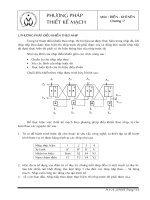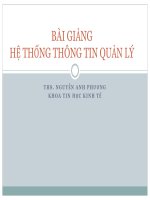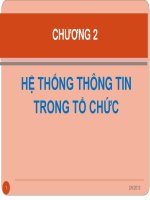SLIDE BÀI GIẢNG MICROECONOMICS
Bạn đang xem bản rút gọn của tài liệu. Xem và tải ngay bản đầy đủ của tài liệu tại đây (1.1 MB, 42 trang )
1- 1
UNIVERSITY OF FINANCE AND MARKETING
MICROECONOMICS
Chapter 1
BASIC
PROBLEMS OF
ECONOMICS
Assoc. PhD.Trần Nguyễn Ngọc Anh Thư
MBA. Đoàn Ngọc Phúc
MBA. Phạm Thị Vân Anh
MBA. Lại Thị Tuyết Lan
MBA. Nguyễn Thị Quý
MBA. Ngô Thị Hồng Giang
MBA. Nguyễn Thị Hảo
HCM City - 2013
1- 2
In this chapter, look for the answers to these
questions:
What kinds of questions does economics address?
What are the principles of how people make decisions?
What are the principles of how people interact?
What are the principles of how the economy as a whole
works?
CHAPTER 1
PRINCIPLES OF ECONOMICS
What Economics Is All About
Scarcity refers to the limited nature of society’s
resources.
Economics is the study of how society
manages its scarce resources, including
– how people decide how much to work, save,
and spend, and what to buy
– how firms decide how much to produce,
how many workers to hire
– how society decides how to divide its resources
between national defense, consumer goods,
protecting the environment, and other needs
CHAPTER 1 PRINCIPLES OF ECONOMICS
1- 3
CLASSIFY
BASES ON RESEARCH SUBJECTS
- Microeconomics
- Macroeconomics
BASES ON METHODOLOGY
- Positive economics
- Normative economics
1- 4
1- 5
Microeconomics and Macroeconomics
Microeconomics is the study of how
households and firms make decisions
and how they interact in markets.
Macroeconomics is the study of economywide phenomena, including inflation,
unemployment, and economic growth.
These two branches of economics are
closely intertwined, yet distinct: they
address different questions.
CHAPTER 2
THINKING LIKE AN ECONOMIST
The Economist as Policy Advisor
As scientists, economists make
positive statements,
which attempt to describe the world as it is.
As policy advisors, economists make
normative statements,
which attempt to prescribe how the world should be.
Positive statements can be confirmed or refuted,
normative statements cannot.
Govt employs many economists for policy advice. E.g.,
the U.S. President has a Council of Economic Advisors,
which the author of this textbook recently chaired.
CHAPTER 2
THINKING LIKE AN ECONOMIST
1- 6
1- 7
3:
Identifying positive vs. normative
ACTIVE LEARNING
Which of these statements are “positive” and which are
“normative”? How can you tell the difference?
a. Prices rise when the government increases the
quantity of money.
b. The government should print less money.
c. A tax cut is needed to stimulate the economy.
d. An increase in the price of gasoline will cause an
increase in consumer demand for video rentals.
7
1- 8
ACTIVE LEARNING
3:
Answers
a. Prices rise when the government increases the quantity
of money.
Positive, describes a relationship, could use data to
confirm or refute.
b. The government should print less money.
Normative, this is a value judgment, cannot be
confirmed or refuted.
8
1- 9
ACTIVE LEARNING
3:
Answers
c. A tax cut is needed to stimulate the economy.
Normative, another value judgment.
d. An increase in the price of gasoline will cause an
increase in consumer demand for video rentals.
Positive, describes a relationship.
Note that a statement need not be true to be positive.
9
Why Economists Disagree
Economists often give conflicting policy
advice.
They sometimes disagree about the validity
of alternative positive theories about the
world.
They may have different values and,
therefore, different normative views about
what policy should try to accomplish.
Yet, there are many propositions about
which most economists agree.
CHAPTER 2
THINKING LIKE AN ECONOMIST
1- 10
Propositions about Which Most
Economists Agree (and % agreeing)
A ceiling on rents reduces the quantity and quality of
housing available. (93%)
Tariffs and import quotas usually reduce general
economic welfare. (93%)
A large federal budget deficit has an adverse effect on
the economy. (83%)
A minimum wage increases unemployment among
young and unskilled workers. (79%)
Effluent taxes and marketable pollution permits
represent a better approach to pollution control than
imposition of pollution ceilings. (78%)
CHAPTER 2
THINKING LIKE AN ECONOMIST
1- 11
HOW PEOPLE MAKE DECISIONS
Decision making is
at the heart of
economics.
The first four
principles deal with
how people make
decisions.
CHAPTER 1 PRINCIPLES OF ECONOMICS
1- 12
HOW PEOPLE MAKE DECISIONS
Principle #1: People Face Tradeoffs
Principle #2: The Cost of Something
Is What You Give Up to Get It
Principle #3: Rational People Think at
the Margin
Principle #4: People Respond to
Incentives./
1- 13
HOW PEOPLE INTERACT
An “economy” is
just a group of
people interacting
with
each other.
The next
three principles
deal with how
people interact.
CHAPTER 1 PRINCIPLES OF ECONOMICS
1- 14
HOW PEOPLE INTERACT
Principle #5: Trade Can Make Everyone
Better Off
Principle #6: Markets Are Usually A Good
Way to Organize Economic Activity
Principle #7: Governments Can Sometimes
Improve Market Outcomes./
1- 15
1- 16
HOW THE ECONOMY AS A WHOLE WORKS
Principle #8: A country’s standard of
living depends on its ability to produce
goods & services.
Principle #9: Prices rise when the
government prints too much money.
Principle #10: Society faces a shortrun tradeoff between inflation and
unemployment./
CONCLUSION
Economics offers many insights about the
behavior of people, markets, and
economies.
It is based on a few ideas that can be
applied in many situations.
Whenever we refer back to one of the
Ten Principles from this chapter,
you will see an icon like this one:
CHAPTER 1 PRINCIPLES OF ECONOMICS
1- 17
1- 18
In this chapter, look for the answers to these
questions:
How is the Production Possibilities Frontier related
to opportunity cost? What other concepts does it
illustrate?
What are models? How do economists use models?
What are the elements of the Circular-Flow Diagram?
What concepts does this diagram illustrate?
CHAPTER 2
THINKING LIKE AN ECONOMIST
1- 19
Our Second Model:
The Production Possibilities Frontier
The Production Possibilities Frontier (PPF):
A graph that shows the combinations of
two goods the economy can possibly produce
given the available resources and the available
technology.
Example:
– Two goods: computers and wheat
– One resource: labor (measured in hours)
– Economy has 50,000 labor hours per month
available for production.
CHAPTER 2
THINKING LIKE AN ECONOMIST
1- 20
PPF Example
Producing one computer requires 100 hours labor.
Producing one ton of wheat requires 10 hours labor.
Employment of
labor hours
Production
Computers
Wheat
Computers
Wheat
A
50,000
0
500
0
B
40,000
10,000
400
1,000
C
25,000
25,000
250
2,500
D
10,000
40,000
100
4,000
E
0
50,000
0
5,000
1- 21
PPF Example
Production
Point
on
Comgraph puters Wheat
A
500
0
B
400
1,000
C
250
2,500
D
100
4,000
E
0
5,000
CHAPTER 2
THINKING LIKE AN ECONOMIST
E
D
C
B
A
1- 22
ACTIVE LEARNING
1:
Points on the PPF
A. On the graph, find the point that represents
(100 computers, 3000 tons of wheat), label it F.
Would it be possible for the economy to produce this
combination of the two goods?
Why or why not?
B. Next, find the point that represents
(300 computers, 3500 tons of wheat), label it G.
Would it be possible for the economy to produce this
combination of the two goods?
22
1- 23
ACTIVE LEARNING
1:
Answers
Point F:
100 computers,
3000 tons wheat
Point F requires
40,000 hours
of labor.
Possible but
not efficient:
could get more
of either good
w/o sacrificing
any of the other.
F
23
1- 24
ACTIVE LEARNING
1:
Answers
Point G:
300 computers,
3500 tons wheat
Point G requires
65,000 hours
of labor.
Not possible
because
economy
only has
50,000 hours.
G
24
1- 25
The PPF: What We Know So Far
Points on the PPF (like A – E)
– possible
– efficient: all resources are fully utilized
Points under the PPF (like F)
– possible
– not efficient: some resources underutilized
(e.g., workers unemployed, factories idle)
Points above the PPF (like G)
– not possible
CHAPTER 2
THINKING LIKE AN ECONOMIST









